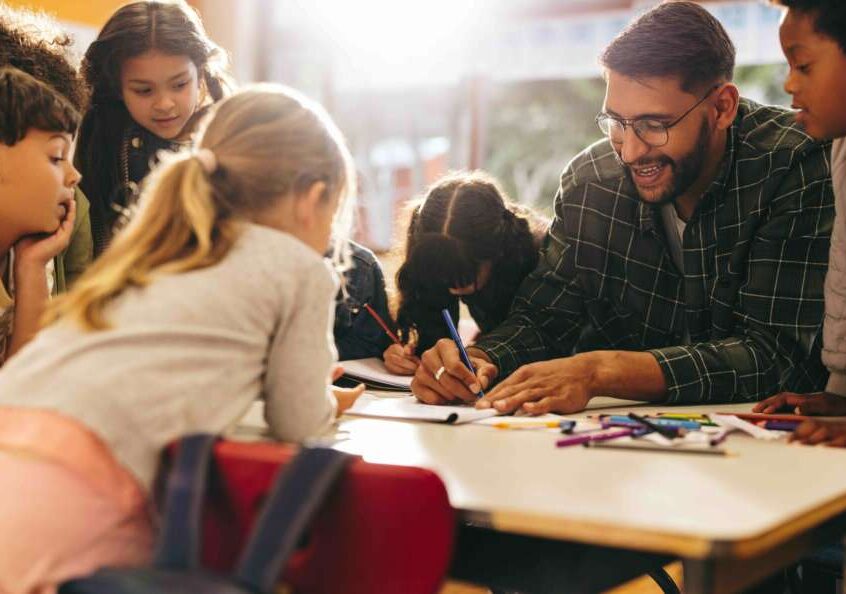CLA’s Senior Policy Associate, Pat Thomson PhD PSM FAcSS, Professor of Education at The University of Nottingham, sets out why arts and cultural learning matter and the importance of responding to the governments curriculum and assessment review.
Right now we are thinking of these words from American writer, Adrienne Maree Brown: “There is an art to flocking: staying separate enough not to crowd each other, aligned enough to maintain a shared direction, and cohesive enough to always move towards each other.” We think if we can all do that, then our collective expressive arts voice will be effectively amplified through this consultation process!
You can find our detailed guidance to support your own submission here.
Pat Thomson on the importance of responding to the governments curriculum and assessment review
The review of the national curriculum is an important opportunity for everyone who knows the importance of cultural learning.
The expressive arts are integral to a broad and balanced curriculum. They:
- teach children to work, alone and together with others, to investigate, develop, interpret and communicate their ideas and understandings
- offer a wide range of genres, media and platforms to learn about the world, the diverse peoples who call England their home and the relationships between people and other living things
- provide a pathway through schooling which can lead to further education and work.
Additionally, arts learning has a range of additional benefits which include self-belief, voice and agency, self-discipline, belonging, wellbeing, collaboration and team work.1 Large-scale studies also point strongly to the arts, and arts subjects, supporting active civic engagement.2
Arts-rich schools show that it is possible to teach both the core and foundation subjects well.3 But we know that many schools struggle to provide meaningful cultural learning for children and young people.4 Arts provision is at best patchy. Enrolments in secondary arts subjects are falling, specialist arts teachers are leaving the profession, the majority of primary teachers get very little education in the expressive arts, and there are not enough specialist primary arts teachers to go around. And this unevenness of expressive arts learning affects some children and localities more than others. Families currently struggling in the current economic climate are totally reliant on their schools to provide the kinds of rich cultural knowledges, skills and experiences that independent schools and more well-off families routinely offer.5 It is not acceptable for only some children to benefit from cultural learning.
Cultural, creative and expressive arts subjects have largely been sustained through the ongoing commitment, energy and skilled practices of individual schools and teachers, arts teachers’ organisations, and dedicated charities and arts companies. We have only to look at Artsmark and Arts Award, the Creativity Collaboratives and Paul Hamlyn Foundation funding for teacher learning to see that the cultural sector and arts funders are committed to redressing the inequitable state of arts learning in schools. Now is surely the time for the government to make renewing expressive arts education a major part of its plans for mainstream curriculum renewal.
The consultations for the curriculum review are a rare opportunity for the cultural education sector to contribute both evidence and advice. It is a significant moment for us to make the case for cultural education. We must ensure that all children have equitable opportunities to explore, enjoy and benefit from the full range of expressive arts subjects.
- E.g. Arts Education Partnership (U.S.), Deasy, R., Catterall, J. S., Hetland, L., & Winner, E. (2002). Critical links: Learning in the arts and student academic and social development. Arts Education Partnership; Hetland, L., Winner, E., Veenema, S. & Sheridan, K. (2013). Studio Thinking 2: The Real Benefits of Arts Education. Teachers College Press; Thomson, PO, Coles, R, Hallewell, M & Keene, J (2014) A critical review of the Creative Partnerships archive: how was cultural value understood, researched and evidenced? Newcastle: CCE; Halverson, E., & Sawyer, K. (2022). Learning in and through the arts. Journal of the Learning Sciences, 31(1), 1–13. Bowen, D & Kisida, B (2023) Investigating the causal effects of arts education. Journal of Policy Analysis and Management 42(3) 624-647. ↩︎
- E.g. Catterall, James S (2009) Doing well and doing good by doing art: The effects of education in the visual and performing arts on the achievements and values of young adults. San Francisco: CreateSpace Independent epublishing Platform; Rabkin, N (2017) Hearts and minds: The arts and civic engagement. Boston, The Rabkin Foundation; Armbruster, A, (2022) Art, democracy, and economics: Measuring the arts’ relationship to civic engagement https://ssrn.com/abstract=4324039 ↩︎
- E.g. Cairns et al (2020) Arts rich schools. RSA https://www.thersa.org/globalassets/pdfs/reports/rsa-arts-rich-schools.pdf; Thomson, P & Hall, C (2023) Cultural citizenship, Arts education for life. London: Routledge; The RAPS project https://artsprimary.com/raps-project/. ↩︎
- See the Cultural Learning Alliance Report Card https://www.culturallearningalliance.org.uk/wp-content/uploads/2024/05/CLA-2024-Annual-Report-Card.pdf; All Party Parliamentary Group for Music Education, Incorporated Society of Musicians & University of Surrey (2019) Music education: State of the nation. https://www.ism.org/images/images/State-of-the-Nation-Music-Education-WEB.pdf; All-Party Parliamentary Group for Art, Craft and Design in Education (2022) Art now: An inquiry into the state of art and design teaching in early years foundation stage, primary and secondary education https://www.nsead.org/files/13a555d0c7a3c66da64bfb8049a4dae1.pdf ↩︎
- Ashton, H & Ashton, D (2022) Creativity and the curriculum: educational apartheid in 21st Century England, a European outlier? International Journal of Cultural Policy 29(4) 484-499 ↩︎




